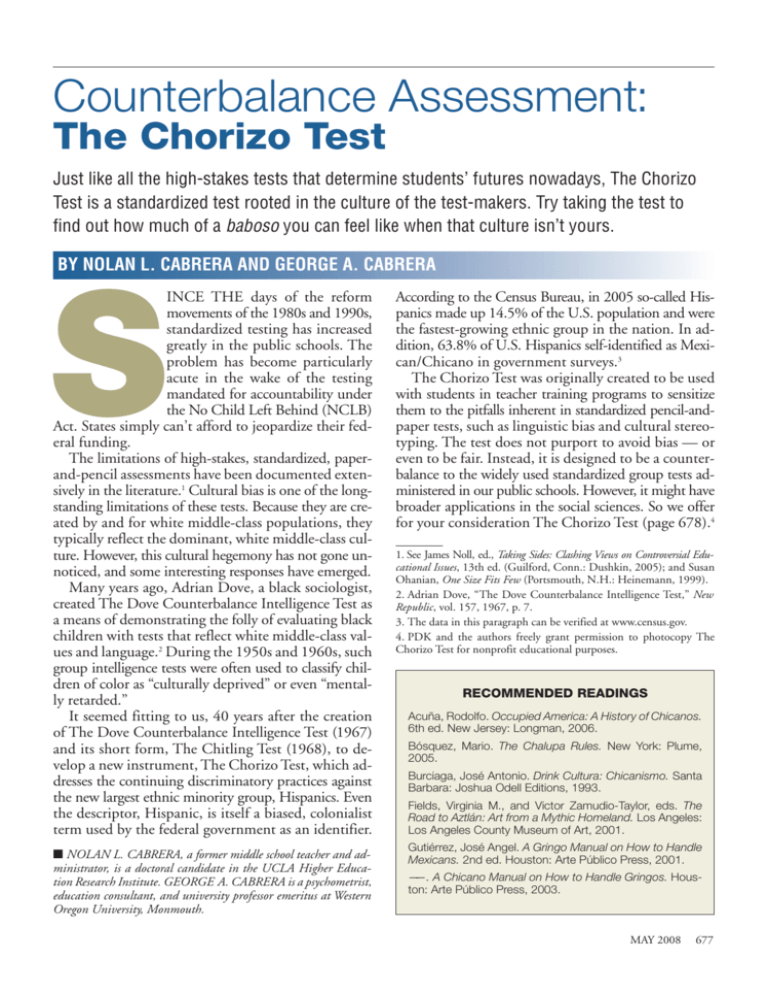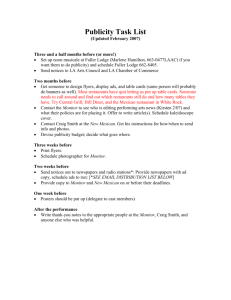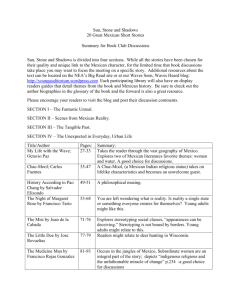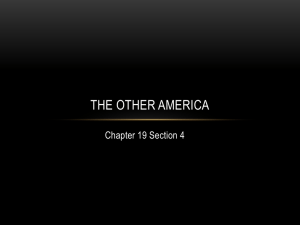
Counterbalance Assessment:
The Chorizo Test
Just like all the high-stakes tests that determine students’ futures nowadays, The Chorizo
Test is a standardized test rooted in the culture of the test-makers. Try taking the test to
find out how much of a baboso you can feel like when that culture isn’t yours.
BY NOLAN L. CABRERA AND GEORGE A. CABRERA
INCE THE days of the reform
movements of the 1980s and 1990s,
standardized testing has increased
greatly in the public schools. The
problem has become particularly
acute in the wake of the testing
mandated for accountability under
the No Child Left Behind (NCLB)
Act. States simply can’t afford to jeopardize their federal funding.
The limitations of high-stakes, standardized, paperand-pencil assessments have been documented extensively in the literature.1 Cultural bias is one of the longstanding limitations of these tests. Because they are created by and for white middle-class populations, they
typically reflect the dominant, white middle-class culture. However, this cultural hegemony has not gone unnoticed, and some interesting responses have emerged.
Many years ago, Adrian Dove, a black sociologist,
created The Dove Counterbalance Intelligence Test as
a means of demonstrating the folly of evaluating black
children with tests that reflect white middle-class values and language.2 During the 1950s and 1960s, such
group intelligence tests were often used to classify children of color as “culturally deprived” or even “mentally retarded.”
It seemed fitting to us, 40 years after the creation
of The Dove Counterbalance Intelligence Test (1967)
and its short form, The Chitling Test (1968), to develop a new instrument, The Chorizo Test, which addresses the continuing discriminatory practices against
the new largest ethnic minority group, Hispanics. Even
the descriptor, Hispanic, is itself a biased, colonialist
term used by the federal government as an identifier.
S
■ NOLAN L. CABRERA, a former middle school teacher and administrator, is a doctoral candidate in the UCLA Higher Education Research Institute. GEORGE A. CABRERA is a psychometrist,
education consultant, and university professor emeritus at Western
Oregon University, Monmouth.
According to the Census Bureau, in 2005 so-called Hispanics made up 14.5% of the U.S. population and were
the fastest-growing ethnic group in the nation. In addition, 63.8% of U.S. Hispanics self-identified as Mexican/Chicano in government surveys.3
The Chorizo Test was originally created to be used
with students in teacher training programs to sensitize
them to the pitfalls inherent in standardized pencil-andpaper tests, such as linguistic bias and cultural stereotyping. The test does not purport to avoid bias — or
even to be fair. Instead, it is designed to be a counterbalance to the widely used standardized group tests administered in our public schools. However, it might have
broader applications in the social sciences. So we offer
for your consideration The Chorizo Test (page 678).4
1. See James Noll, ed., Taking Sides: Clashing Views on Controversial Educational Issues, 13th ed. (Guilford, Conn.: Dushkin, 2005); and Susan
Ohanian, One Size Fits Few (Portsmouth, N.H.: Heinemann, 1999).
2. Adrian Dove, “The Dove Counterbalance Intelligence Test,” New
Republic, vol. 157, 1967, p. 7.
3. The data in this paragraph can be verified at www.census.gov.
4. PDK and the authors freely grant permission to photocopy The
Chorizo Test for nonprofit educational purposes.
RECOMMENDED READINGS
Acuña, Rodolfo. Occupied America: A History of Chicanos.
6th ed. New Jersey: Longman, 2006.
Bósquez, Mario. The Chalupa Rules. New York: Plume,
2005.
Burciaga, José Antonio. Drink Cultura: Chicanismo. Santa
Barbara: Joshua Odell Editions, 1993.
Fields, Virginia M., and Victor Zamudio-Taylor, eds. The
Road to Aztlán: Art from a Mythic Homeland. Los Angeles:
Los Angeles County Museum of Art, 2001.
Gutiérrez, José Angel. A Gringo Manual on How to Handle
Mexicans. 2nd ed. Houston: Arte Público Press, 2001.
——. A Chicano Manual on How to Handle Gringos. Houston: Arte Público Press, 2003.
MAY 2008
677
THE CHORIZO TEST
Directions: Please select what you think is the best answer for each item below.
3. Cinco de Mayo is:
a. A celebration of the
beginning of spring in
Mexico
b. A celebration of Mexican
Independence Day
c. A Mexican military victory
over the French at Puebla
d. A Mexican salad dressing
e. A celebration of Mexican
St. Patrick’s Day
4. Dolores Huerta is:
a. A well-known newscaster
on Telemundo
b. The mother of the Chicano
movement
c. The most recognized
Chicana in advertising
d. A successful Latina
business executive
e. A popular telenovela star
5. A gabacho is a:
a. Vegetable
b. Cowboy
c. Fruit
d. White male
e. Horse rider
6. “¡Huelga!” means:
a. “Strike!”
b. “Careful!”
c. “Watch out!”
d. “Halt!”
e. “Stop!”
678
PHI DELTA KAPPAN
8. La Llorona:
a. Lights the way for travelers
b. Cries for her children whom
she killed
c. Is a sign of the four
seasons
d. Prays and cares for the
safety of the family
e. Stands for anger and
revenge
9. La Raza means:
a. The politics
b. The public
c. The family
d. The nation
e. The race
10. El Norte refers to:
a. The North Pole
b. Canada
c. Alaska
d. The United States
e. Baja California
11. La Virgen de
Guadalupe is the:
a. Bridge between EI Paso
and Juárez
b. Sign of a good autumn
harvest
c. Child who represents
innocence
d. Final stop before crossing
into the U.S.
e. Patron saint of Mexico
12. MEChA is a:
a. Legal assistance group
b. Student activist group
c. Federal aid group
d. Business support group
e. Political immigration group
13. Menudo is:
a. Breakfast of Champions
b. Dark chocolate candy
c. Music played at a wedding
d. A form of self-defense
e. An iron cooking skillet
14. An Americanized
Mexican is known as a:
a. Pachuco
b. Pocho
c. Tío
d. Muchacho
e. Primo
15. Which word is out of
place here?
a. Nopales
b. Caldo
c. Chancla
d. Chalupa
e. Chorizo
22. What term does not fit
with the rest?
a. Vato
b. Amigo
c. Carnal
d. Esé
e. Patrón
16. The word that does not
fit is:
a. Curandero
b. Estúpido
c. Tonto
d. Pendejo
e. Baboso
23. La migra is:
a. Spanish for “Minutemen”
b. A group of undocumented
workers
c. A street gang from East
Los Angeles
d. The immigration
enforcement patrol
e. The most vocal Mexican
political group
17. Quetzalcóatl is:
a. The patron saint of the
poor
b. Clothing worn by peasants
c. A small restaurant with
home cooking
d. The Mayan leader who
fought Cortez
e. An Aztec god
18. A Quinceañera is a:
a. Place of worship for lost
children
b. Group of small family farms
c. Festival of lights during
January
d. Fifteenth birthday
celebration
e. Strong herb used for
healing
24. Río Bravo is:
a. The Mexican Medal of
Honor
b. A rich Mexican landowner
c. The same as Rio Grande
d. A well-known Mexican
cowboy movie
e. A popular Mexican play
performed outside
25. Nochebuena is another
name for:
a. Poinsettia
b. “El Che”
c. Corona beer
d. Disneyland
e. Night of the Kings
19. September 16th is:
a. President’s Day in Mexico
b. The running of the bulls
c. Mexican Independence
Day
d. Día de los Muertos
e. Registration day for voting
20. “Sí se puede” means:
a. “Yes, we can.”
b. “My house is your house.”
c. “I am somebody.”
d. “Keep hope alive.”
e. “Choose wisely.”
21. The Battle of the Alamo
was:
a. A major victory for the
Republic of Texas
b. An attempt to rid Mexico of
illegal Americans
c. The beginning of the
Mexican Revolution
d. Fought by American
Minutemen
e. A defeat for Mexican
General Santa Ana
ANSWER KEY
3. c 4. b 5. d
8. b 9. e 10. d
13. a 14. b 15. c
18. d 19. c 20. a
23. d 24. c 25. a
2. César Chávez is best
known as:
a. A fictional character in the
Zorro movies
b. The first Chicano
representative to the U.S.
Congress
c. A writer known for his best
seller, Letters from the
Fields
d. Lead guitarist for Santana
e. A union leader who
organized farm workers
7. El Chupacabra is a:
a. Decorated piñata
b. Man’s belt buckle
c. Mythical devil
d. Famous racehorse
e. Movie hero
1. d 2. e
6. a 7. c
11. e 12. b
16. a 17. e
21. b 22. e
1. Aztlán is:
a. A territory created by the
Treaty of Guadalupe
Hidalgo
b. A popular Mexican fastfood chain
c. The Mexican capital of the
Republic of Chino
d. The mythic native land of
the Aztecs
e. A resort on the Mexican
Riviera
File Name and Bibliographic Information
k0805cab.pdf
Nolan L. Cabrera and George A. Cabrera, Counterbalance
Assessment: The Chorizo Test, Phi Delta Kappan, Vol. 89, No. 09,
May 2008, pp. 677-678.
Copyright Notice
Phi Delta Kappa International, Inc., holds copyright to this article, which
may be reproduced or otherwise used only in accordance with U.S. law
governing fair use. MULTIPLE copies, in print and electronic formats, may
not be made or distributed without express permission from Phi Delta
Kappa International, Inc. All rights reserved.
Note that photographs, artwork, advertising, and other elements to which
Phi Delta Kappa does not hold copyright may have been removed from
these pages.
All images included with this document are used with permission and
may not be separated from this editoral content or used for any other
purpose without the express written permission of the copyright holder.
Please fax permission requests to the attention of KAPPAN Permissions
Editor at 812/339-0018 or e-mail permission requests to
kappan@pdkintl.org.
For further information, contact:
Phi Delta Kappa International, Inc.
408 N. Union St.
P.O. Box 789
Bloomington, Indiana 47402-0789
812/339-1156 Phone
800/766-1156 Tollfree
812/339-0018 Fax
http://www.pdkintl.org
Find more articles using PDK’s Publication Archives Search at
http://www.pdkintl.org/search.htm.








